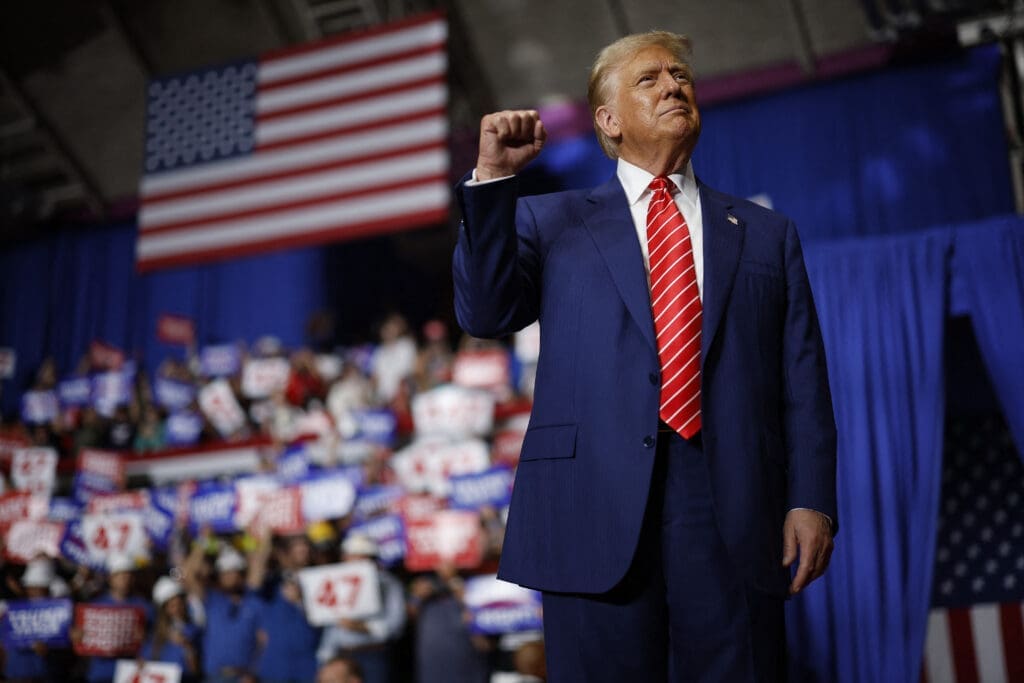One hundred days ahead of elections in November, former U.S. president Donald Trump is polling strongly despite the emergence of Vice President Kamala Harris as the Democrat candidate. What would the implications be for us in the Gulf and around the world of a Trump presidency redux?
From public statements and his record in the previous 2017 to 2021 term, we can identify the basic tenets of such a presidency as nationalism, isolationism, protectionism, populism and a clampdown on migration. In other words: “Maganomics” (after Trump’s slogan, Make America Great Again).
Whether fully or partially adopted, Project 2025, a 900-page blueprint for office by a conservative think tank, offers further clues on the direction of a radical new Trump government.
The policies of such an administration would have an impact around the world, with direct and spillover effects on the Middle East.
In the first place, the trade, fiscal, energy and deregulation policies advocated by Trump, along with a crackdown on immigration, are inflationary in nature.
These could increase U.S. nominal GDP but imply even higher U.S. budget deficits—currently running at 6.7% of GDP—and Federal debt, which already exceeds 100% of GDP.
A resurgence of inflation would force the U.S. Federal Reserve to keep interest rates higher for longer, delaying any monetary easing. This would boost the dollar at a time when other G7 central banks, including the European Central Bank and the Bank of England, are easing rates.
Higher, longer lasting interest rates and a strong U.S. dollar would affect emerging markets negatively via higher inflation and bigger budget and trade deficits.
MENA countries such as Egypt and Tunisia with high external debt to GDP could be particularly impacted. Higher U.S. interest rates would exacerbate the growing crisis in which global public debt already exceeds $100 trillion, and implies higher servicing burdens.
Macroeconomic risks—sovereign defaults, market failure and unexpected shocks—would grow.
Secondly, Maganomics focuses on protectionism. An “America First” agenda means higher U.S. tariffs. Trump has spoken of imposing higher import tariffs of 10% across the board and 60% on China, leading to greater fragmentation in global trade and investment.
Anti-dumping measures could affect Gulf Cooperation Council (GCC) industrial exports to the U.S., including steel, aluminum and petrochemicals.
Conflict with China over trade and tech and de-coupling measures—to say nothing of Taiwan—could slow growth in the former and lower oil and gas imports in the world’s second largest economy.
All these have negative implications for GCC exports and growth. This could be mitigated by China’s growing non-oil linkages with the GCC, which span clean energy, financial integration, tourism and tech.
A ramping up of U.S.-China economic warfare could turn out to be a net positive for the GCC. In an illustration of the “law of unintended consequences,” China could divert trade and investment to the GCC and the Middle East.
Thirdly, energy is a major plank of Maganomics. Short of repealing the Inflation Reduction Act or the Infrastructure Investment and Jobs Act, a Trump administration would pursue aggressive federal deregulation. Its policies would ramp up investment in energy infrastructure and resources. It would also likely remove drilling restrictions in Alaska and the Gulf of Mexico and cut clean energy subsidies.
The objective would be to galvanize the U.S. as a major oil and gas exporter, while Russia is sanctioned and displaced from EU markets. U.S. crude oil exports reached a record in 2023, averaging 4.1 million barrels per day. The U.S. was also the top exporter of LNG globally in 2023, averaging 11.9 billion cubic feet per day.
Deregulation of the oil and gas industry could boost U.S. exports and lower oil prices, providing competition for OPEC+ and the GCC.
Fourthly, a new Trump administration might reverse climate commitments—the U.S. is the world’s second-top emitter of greenhouse gases—and reduce spending on climate risk mitigation and adaptation and climate tech. This implies that temperatures would increase globally beyond 1.5C.
This year saw cities scorched by some of the hottest summers on record. The coming decade is likely to be even hotter. This could however offer an opportunity for GCC to increase its renewable, clean energy and climate tech exports.
The bottom line is that Maganomics means headwinds for the GCC. Regional geopolitical risks would grow, coupled with uncertainty on likely impacts.
To counter, the GCC states individually and collectively should maintain their strategic course. They should increase openness through trade and investment agreements, focus on greater economic diversification and regional integration, pursue green industrial policies and invest in renewable energies and climate tech.


